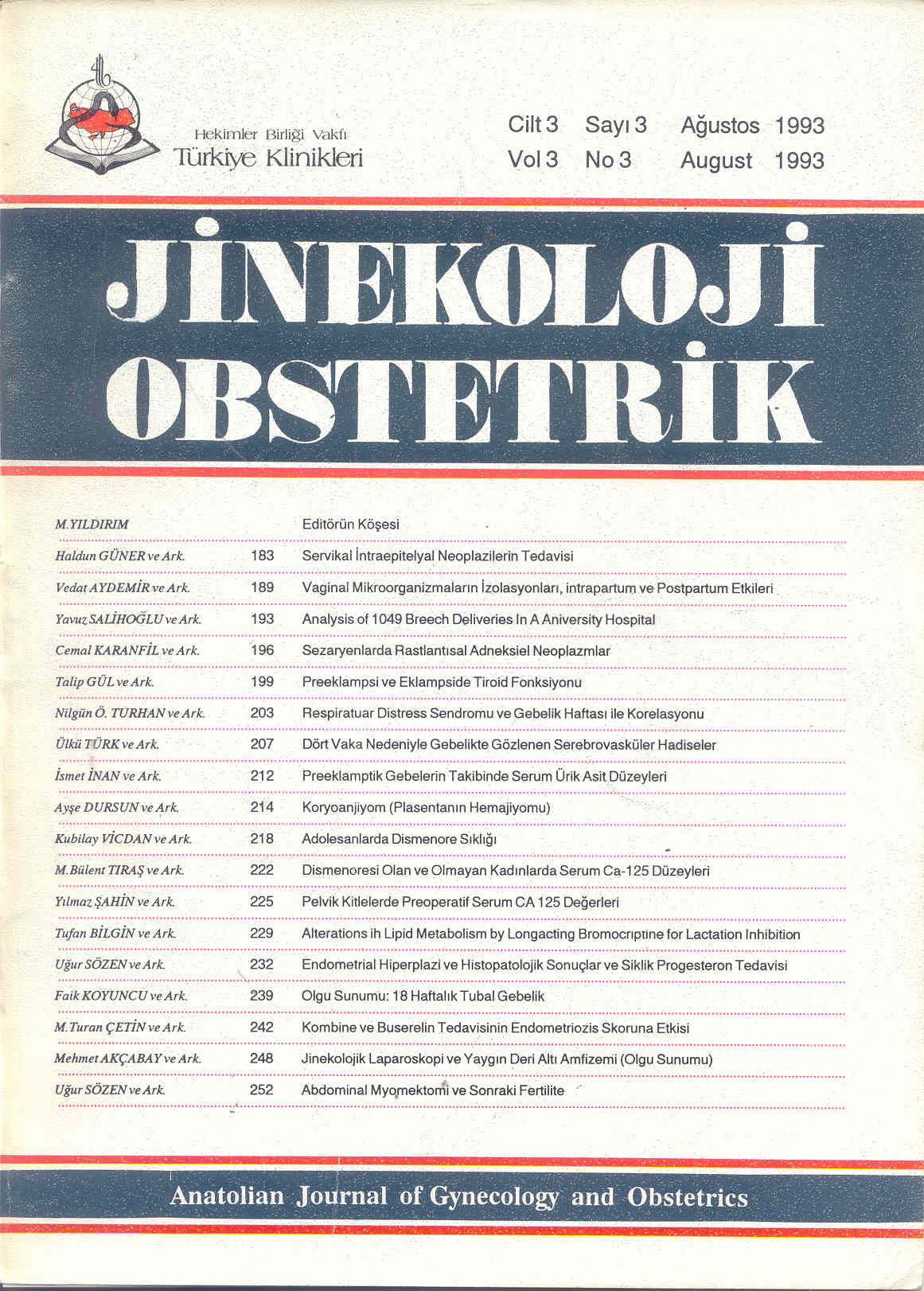Open Access
Peer Reviewed
ARTICLES
5865 Viewed2674 Downloaded
Endometrial Hiperplazide Siklik Progesteron Tedavisi ve Histopatolojik Sonuçların Değeriendirilmesi
Endometrial Hiperplazide Siklik Progesteron Tedavisi ve Histopatolojik Sonuçların Değeriendirilmesi
Turkiye Klinikleri J Gynecol Obst. 1993;3(3):232-8
Article Language: TR
Copyright Ⓒ 2025 by Türkiye Klinikleri. This is an open access article under the CC BY-NC-ND license (http://creativecommons.org/licenses/by-nc-nd/4.0/)
ÖZET
Endometrial hiperplazi östrojenik stimülasyon sonucu ortaya çıkan endometriumun hiperplastik gelişimidir: Basit glandüler hiperpaziden iyi diferansiye adenokarsinoma kadar geniş bir spektruma sahiptir. Endometrial hiperplazili hastalar, endometrium karsinomlu hastalarla aynı risk faktörlerine sahiptirler. 60 endometrial hiperplazili hasta çalışma kapsamına alındı. 26 hastaya medroksiprogesteron asetat (MPA), 34 hastaya noretisteron asetat (NEA) verilerek tedavi etkinlikleri karşılaştırıldı. Çalışma grubunda ortalama yaş 42.8 ± 6.83 yıl, parite ortalaması 2.83 ± 1.90 olarak bulundu. %40 hastada hipertansiyon, %35 hastada diabet, %56.7 hastada obezite tespit edildi. Kontrol probe küretaj sonucunda; MPA ile 22 (%84.5), NEA ile 23 (%67.6) hastanın tedavi olduğu bulundu. Her iki ilaç arasında tedavi etkinliği yönünden istatistiki olarak fark yoktu (p> 0.05). MPA'nın bez epitelleri üzerine NEA'ya göre daha fazla etki gösterdiği ve aradaki farkın önemli olduğu bulundu (p> 0.05). MPA verilen hastalarda, NEA verilen hastalara göre daha az yan etki meydana geldiği ve daha fazla hastada çekilme kanaması meydana getirdiği saptandı. MPA'nın endometrial hiperplazinin tedavisinde seçilecek ilk ilaç olması gerektiği sonucuna varıldı.
Endometrial hiperplazi östrojenik stimülasyon sonucu ortaya çıkan endometriumun hiperplastik gelişimidir: Basit glandüler hiperpaziden iyi diferansiye adenokarsinoma kadar geniş bir spektruma sahiptir. Endometrial hiperplazili hastalar, endometrium karsinomlu hastalarla aynı risk faktörlerine sahiptirler. 60 endometrial hiperplazili hasta çalışma kapsamına alındı. 26 hastaya medroksiprogesteron asetat (MPA), 34 hastaya noretisteron asetat (NEA) verilerek tedavi etkinlikleri karşılaştırıldı. Çalışma grubunda ortalama yaş 42.8 ± 6.83 yıl, parite ortalaması 2.83 ± 1.90 olarak bulundu. %40 hastada hipertansiyon, %35 hastada diabet, %56.7 hastada obezite tespit edildi. Kontrol probe küretaj sonucunda; MPA ile 22 (%84.5), NEA ile 23 (%67.6) hastanın tedavi olduğu bulundu. Her iki ilaç arasında tedavi etkinliği yönünden istatistiki olarak fark yoktu (p> 0.05). MPA'nın bez epitelleri üzerine NEA'ya göre daha fazla etki gösterdiği ve aradaki farkın önemli olduğu bulundu (p> 0.05). MPA verilen hastalarda, NEA verilen hastalara göre daha az yan etki meydana geldiği ve daha fazla hastada çekilme kanaması meydana getirdiği saptandı. MPA'nın endometrial hiperplazinin tedavisinde seçilecek ilk ilaç olması gerektiği sonucuna varıldı.
ANAHTAR KELİMELER: Endometrial hiperplazi, progesteron tedavisi
ABSTRACT
Endometrial hyperplasia is a hyperplastic growth of the endometrium resulting from unopposed estrogenic stimulation on the endometrium. It has a broad spectrum beginning from the simple glandular hyperplasia to the well-differentiated carcinoma. The patients with endometrial hyperplasia have the same risk factors as the patients with endometrial carcinoma do. Sixty patients with endometrial hyperplasia were included in this study. Medroxyprogesteron acetate (MPA) was administered to 26 patients. Norethisteron acetate (NEA) was administered to 34 patients and treatment effectiveness of these drugs was compared. In the study group, average age was found out to be 42.8 ± 6.83 years and average parity was 2.83 ± 1.90. It was determined that 40% of the patients had hypertension, 35% of the patients had diabetes mellitus and 56.7% of the patients had obesity. In the result of the control probe curettage, it was found out that 22 (84.6%) patients of MPA group and 23 (67.6%) patients of NEA group were cured. There were no statistically significant differences in terms of affecting the stroma (p> 0.05). It was determined that the patients treated with MPA had less side effects and more withdrawal bleeding than the patients treated with NEA. It was concluded that MPA was the first choice to be considered in the treatment of endometrial hyperplasia.
Endometrial hyperplasia is a hyperplastic growth of the endometrium resulting from unopposed estrogenic stimulation on the endometrium. It has a broad spectrum beginning from the simple glandular hyperplasia to the well-differentiated carcinoma. The patients with endometrial hyperplasia have the same risk factors as the patients with endometrial carcinoma do. Sixty patients with endometrial hyperplasia were included in this study. Medroxyprogesteron acetate (MPA) was administered to 26 patients. Norethisteron acetate (NEA) was administered to 34 patients and treatment effectiveness of these drugs was compared. In the study group, average age was found out to be 42.8 ± 6.83 years and average parity was 2.83 ± 1.90. It was determined that 40% of the patients had hypertension, 35% of the patients had diabetes mellitus and 56.7% of the patients had obesity. In the result of the control probe curettage, it was found out that 22 (84.6%) patients of MPA group and 23 (67.6%) patients of NEA group were cured. There were no statistically significant differences in terms of affecting the stroma (p> 0.05). It was determined that the patients treated with MPA had less side effects and more withdrawal bleeding than the patients treated with NEA. It was concluded that MPA was the first choice to be considered in the treatment of endometrial hyperplasia.
MENU
POPULAR ARTICLES
MOST DOWNLOADED ARTICLES





This journal is licensed under a Creative Commons Attribution-NonCommercial-NoDerivatives 4.0 International License.










